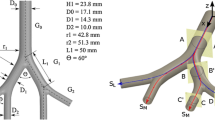Abstract
In our respiratory system, trachea–bronchi geometry is very complex in nature, which gives rise to the intricate airflow patterns. Since along with air, many other pollutants and dust particles go inside our respiratory system resulting in various lung problems like asthma, bronchiole inflammation, chronic bronchitis, and other infectious diseases like influenza and pneumonia. Thus, it is essential to understand fluid flow patterns, related stresses, and their effects inside the human airways. In most of the research till now, the role of the elasticity of the walls of human airways is neglected due to the computational difficulties. Here, we performed a two-way coupled fluid–structure interaction analysis on a double bifurcation geometry (G3 to G5) using finite volume approach for Re = 500 and Re = 2000, keeping the mass flow rate constant. The solid walls of human airways are considered to be of isotropic material. With including the elasticity, we were able to predict the more physical values of the stresses. We observed that maximum deformation in the geometry occurs at first bifurcation for low Reynolds number and the branch G5M for high Reynolds number. High values of Von-Mises stress are also observed at the point of bifurcations.
Access this chapter
Tax calculation will be finalised at checkout
Purchases are for personal use only
Similar content being viewed by others
References
Schroter RC, Sudlow MF (1969) Flow patterns in models of the human bronchial airways. Respir Physiol 7(3):341–355
Zhao Y, Lieber BB (1994) Steady inspiratory flow in a model symmetric bifurcation. J Biomech Eng 116(4):488–496
Comer JK, Kleinstreuer C, Zhang Z (2001) Flow structures and particle deposition patterns in double-bifurcation airway models. Part 1. Air flow fields. J Fluid Mech 435:25–54
Augusto LLX, Lopes GC, Goncalves JAS (2016) A CFD study of deposition of pharmaceutical aerosols under different respiratory conditions. Braz J Chem Eng 33(3):549–558
Weibel ER, Cournand AF, Richards DW (1963) Morphometry of the human lung, vol 1. Springer, Berlin
Sera T, Satoh S, Horinouchi H, Kobayashi K, Tanishita K (2003) Respiratory flow in a realistic tracheostenosis model. J Biomech Eng 125(4):461–471
Croteau JR, Cook CD (1961) Volume-pressure and length-tension measurements in human tracheal and bronchial segments. J Appl Physiol 16(1):170–172
Prakash UB, Hyatt RE (1978) Static mechanical properties of bronchi in normal excised human lungs. J Appl Physiol 45(1):45–50
Turek S, Hron J (2006) Proposal for numerical benchmarking of fluid-structure interaction between an elastic object and laminar incompressible flow. In: Fluid-structure-interaction. Springer, Berlin, pp 371–385
Longest PW, Vinchurkar S (2007) Validating CFD predictions of respiratory aerosol deposition: effects of upstream transition and turbulence. J Biomech 40(2):305–316
Acknowledgements
The authors would like to acknowledge the High-Performance Computing (HPC) Facility at IIT Kanpur (www.iitk.ac.in/cc) for providing the necessary environment to perform the above study.
Author information
Authors and Affiliations
Corresponding author
Editor information
Editors and Affiliations
Rights and permissions
Copyright information
© 2021 Springer Nature Singapore Pte Ltd.
About this paper
Cite this paper
Verma, M., Karmanya, Verma, A., De, A. (2021). Coupled Fluid–Structure Study of Inspiratory Flow Through Human Airways with Double Bifurcation. In: Venkatakrishnan, L., Majumdar, S., Subramanian, G., Bhat, G.S., Dasgupta, R., Arakeri, J. (eds) Proceedings of 16th Asian Congress of Fluid Mechanics. Lecture Notes in Mechanical Engineering. Springer, Singapore. https://doi.org/10.1007/978-981-15-5183-3_10
Download citation
DOI: https://doi.org/10.1007/978-981-15-5183-3_10
Published:
Publisher Name: Springer, Singapore
Print ISBN: 978-981-15-5182-6
Online ISBN: 978-981-15-5183-3
eBook Packages: EngineeringEngineering (R0)




